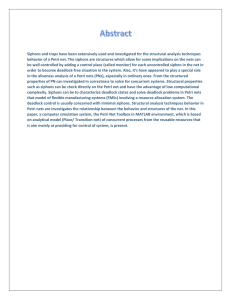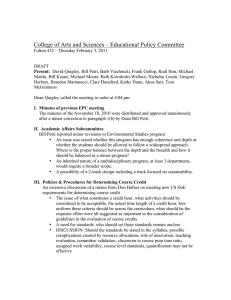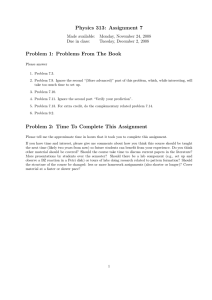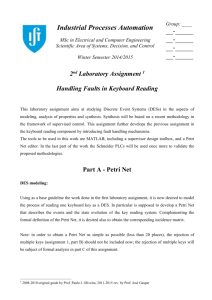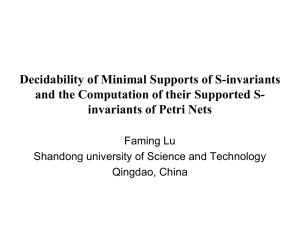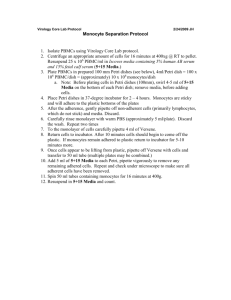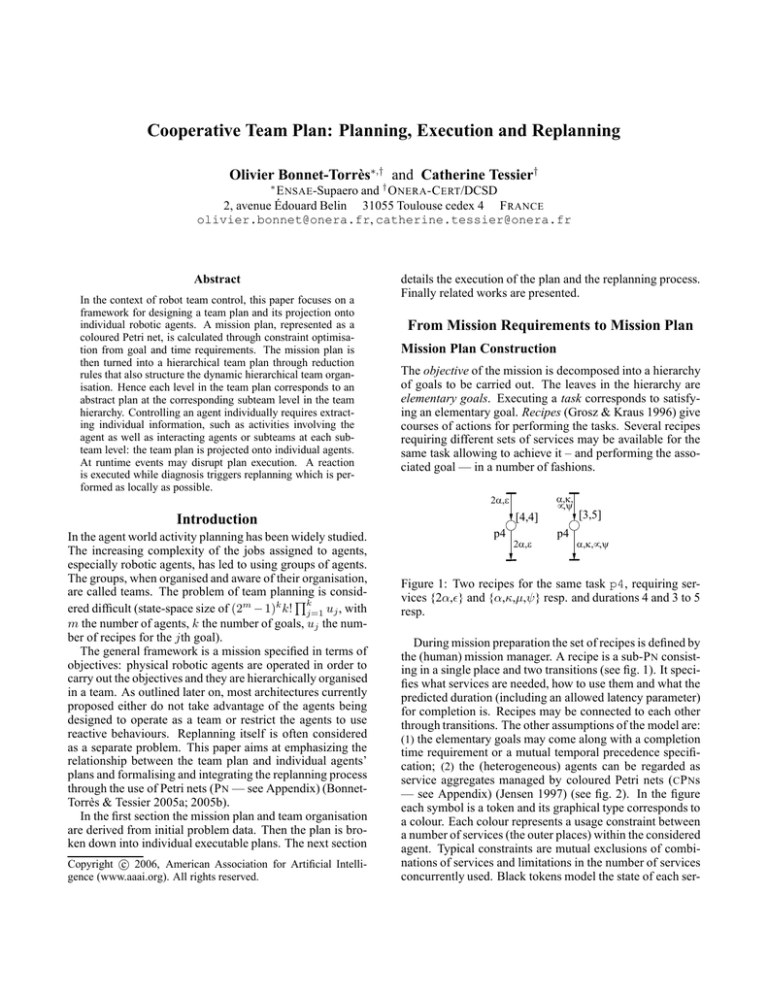
Cooperative Team Plan: Planning, Execution and Replanning
Olivier Bonnet-Torrès∗,† and Catherine Tessier†
∗
E NSAE-Supaero and † O NERA -C ERT/DCSD
2, avenue Édouard Belin 31055 Toulouse cedex 4 F RANCE
olivier.bonnet@onera.fr, catherine.tessier@onera.fr
Abstract
In the context of robot team control, this paper focuses on a
framework for designing a team plan and its projection onto
individual robotic agents. A mission plan, represented as a
coloured Petri net, is calculated through constraint optimisation from goal and time requirements. The mission plan is
then turned into a hierarchical team plan through reduction
rules that also structure the dynamic hierarchical team organisation. Hence each level in the team plan corresponds to an
abstract plan at the corresponding subteam level in the team
hierarchy. Controlling an agent individually requires extracting individual information, such as activities involving the
agent as well as interacting agents or subteams at each subteam level: the team plan is projected onto individual agents.
At runtime events may disrupt plan execution. A reaction
is executed while diagnosis triggers replanning which is performed as locally as possible.
details the execution of the plan and the replanning process.
Finally related works are presented.
From Mission Requirements to Mission Plan
Mission Plan Construction
The objective of the mission is decomposed into a hierarchy
of goals to be carried out. The leaves in the hierarchy are
elementary goals. Executing a task corresponds to satisfying an elementary goal. Recipes (Grosz & Kraus 1996) give
courses of actions for performing the tasks. Several recipes
requiring different sets of services may be available for the
same task allowing to achieve it – and performing the associated goal — in a number of fashions.
α,κ,
µ,ψ
2α,ε
[4,4]
Introduction
In the agent world activity planning has been widely studied.
The increasing complexity of the jobs assigned to agents,
especially robotic agents, has led to using groups of agents.
The groups, when organised and aware of their organisation,
are called teams. The problem of team planning is considQk
ered difficult (state-space size of (2m − 1)k k! j=1 uj , with
m the number of agents, k the number of goals, uj the number of recipes for the jth goal).
The general framework is a mission specified in terms of
objectives: physical robotic agents are operated in order to
carry out the objectives and they are hierarchically organised
in a team. As outlined later on, most architectures currently
proposed either do not take advantage of the agents being
designed to operate as a team or restrict the agents to use
reactive behaviours. Replanning itself is often considered
as a separate problem. This paper aims at emphasizing the
relationship between the team plan and individual agents’
plans and formalising and integrating the replanning process
through the use of Petri nets (P N — see Appendix) (BonnetTorrès & Tessier 2005a; 2005b).
In the first section the mission plan and team organisation
are derived from initial problem data. Then the plan is broken down into individual executable plans. The next section
c 2006, American Association for Artificial IntelliCopyright gence (www.aaai.org). All rights reserved.
p4
2α,ε
p4
[3,5]
α,κ,µ,ψ
Figure 1: Two recipes for the same task p4, requiring services {2α,ǫ} and {α,κ,µ,ψ} resp. and durations 4 and 3 to 5
resp.
During mission preparation the set of recipes is defined by
the (human) mission manager. A recipe is a sub-P N consisting in a single place and two transitions (see fig. 1). It specifies what services are needed, how to use them and what the
predicted duration (including an allowed latency parameter)
for completion is. Recipes may be connected to each other
through transitions. The other assumptions of the model are:
(1) the elementary goals may come along with a completion
time requirement or a mutual temporal precedence specification; (2) the (heterogeneous) agents can be regarded as
service aggregates managed by coloured Petri nets (C P Ns
— see Appendix) (Jensen 1997) (see fig. 2). In the figure
each symbol is a token and its graphical type corresponds to
a colour. Each colour represents a usage constraint between
a number of services (the outer places) within the considered
agent. Typical constraints are mutual exclusions of combinations of services and limitations in the number of services
concurrently used. Black tokens model the state of each ser-
δ
γ
β
+2
+2
+2*
+2
+2
+2 *
4
4
+2*
+
+2 *
+
+2 *
+
+2 *
α
ε
+
+2 *
3
**
***
***
3
+3*
Mission Plan and Agenticity Hierarchy
+2*
+2*
ρ
+
+2*
+3*
+2*
ν
η
+ +2*
+ +2*
Time specification of a task partly derives from the goals it
(totally or partly) achieves and may include a duration, a
start time interval, a stop time interval and a maximum latency after finish (the next task must start before the maximum latency in order for the current task to have a valid
result). The last part is a list of all agents with their services
and internal constraints. The agents are described as collections of services (see fig. 2). The problem is solved thanks
to choco1 , an open-source constraint optimisation and satisfaction Java library.
+
+2*
+3*
κ
+3*
λ
µ
Figure 2: An agent viewed as a collection of services. (Each
type of symbol is a colour; greek letters designate the services.)
vice (either free or in use). White tokens represent the remaining amount for consumable services as for κ.
Example 1 The lozenge colour (♦) represents the general
limitation of four services used at the same time; α prevents
the use of any other service and η limits the number of concurrent service use to only one. Practically lozenges represent the battery instant power consumption and service α
is “emit marker signal” which consists in sending a powerful geographical reference signal from a fixed location. η
is “emit video stream” which heavily draws on battery current and β is “get video stream” which also uses the camera (modelled by triangles N) and co-processor bandwidth
(stars ∗).
The triangles (N) symbolise the exclusion in accessing the
camera between the use of β and any of ǫ (“grab single image”) and λ (“detect object”). ǫ and λ can be performed on
the same image and thus can be used at the same time.
The mission plan is a solution of a constrained optimisation problem: knowing that services may have mutual exclusion constraints within each agent and that several recipes
are available to perform each elementary goal, the construction process output is a partial preorder on the goals that respects their constraints colocated with a dynamic agent service allocation. Each goal is performed according to a recipe
to which some agents are attached so that both agent-internal
constraints (service exclusion) and external constraints (time
specifications and service requirements for each recipe) are
satisfied. Technically the problem is described in three parts.
The first one is the goal tree with time specifications and
some global options such as the factors to apply to the different terms in the optimisation function (prevalence of time,
goal achievement, or costs). The second part describes for
each elementary goal (i.e. each task) the different recipes
available and their requirements in terms of services or time.
The output of the constraint solver is interpreted as the mission plan but is also a schedule: it corresponds to a detailed
sequence of tasks with dynamic service allocation. According to the goals some recipes are chosen to performed tasks
and the agents are allocated to the recipes as colour parameters. The recipe time parameters are instantiated to meet
time requirements as well as minimise completion time.
Then recipes are chained to each other by fusing transitions
in order to form the plan, which is represented as a C P N
(see fig. 4). The set of token colours is the set of elementary
agents. Each reachable marking M represents the allocation
of the agents to the corresponding tasks: a possible organisation of the team is attached to the plan.
Since a group of closely interacting agents can be considered as an agent in itself (Shoham 1993), a subteam of
agents is equivalent to a composite agent. This agent bears
an agenticity hierarchy, whose leaves are elementary agents
and whose nodes are subteams, i.e. composite agents. Each
node has for children nodes the agents that compose the subteam it represents. There is no requirement that an individual agent be represented only once: an agent may belong
to several subteams (therefore the hierarchy is not a tree).
For instance agent x1 can use its camera for taking a coordinated stereo picture of an object and at the same time send a
message to another subteam reporting the local ground adherence.
More formally the team X is composed of hierarchically organised elementary agents {x1 , x2 , . . . , xn }. Let
A = {a1 , a2 , . . . , am } be the set of agents in X. The agenticity of agent ai with regards to any subteam aj , ai ⊂ aj
(including X) is its depth in the hierarchy Haj whose root
is the considered subteam (see fig. 3).
composite
agent
agenticity
team
0
1
agent
subteam
agent
2
agenticity
wrt the
subteam
0
agent
subsubteam
agent 1
elementary
agent
3
= degree of
the team
= max
(agenticity)
team
agent
agent
subteam
Figure 3: Hierarchy of agenticity
1
2 = degree of
the subteam
= max (agenticity)
http://choco.sourceforge.net
team
team
A
a
b d
p1
B
g
b c e f
g
a
p2
g
d e f
b c
p3
team
p4
●
●
p5
●
p6
A
p8a
p7 ●
B
AA’
AB’
b c e f g
team
p9
p10
p8b
a b g
d
g
p12
A
B
p13
p11
AA
AAA
AB
AAB
team
g
b c
e f
a d g
p14
a
b c
g
d e f
a b g a b g
Figure 4: Mission plan with some agenticity hierarchies derived from the initial allocation
As the marking evolves during plan execution, the organisation of the team changes letting the agenticity hierarchy
be dynamic. Since it reflects the interactions between agents
and subteams, the agenticity hierarchy provides a means to
monitor and diagnose team activity and henceforth a hint for
determining the parts of the plan to be repaired.
Petri net analysis can be performed through the use of the
incidence matrix A (Murata 1989). A represents the relations between places and transitions, namely the arcs. The
arcs provide a visual verification that no agent can leave a
subteam if it has not been planned.
animation and analysis tool2 . An example of mission plan is
provided in figure 5.
From Mission Plan to Individual Plans
Planning is not an end in itself. The ultimate goal is to execute a mission on physical robotic entities. Hence each of
these robots needs to have a valid executable plan. Therefore the mission plan has to be adapted to the individuals.
The idea is then to project the team plan onto individual
agents. Indeed the mission plan bears some typical structures that can be identified as modifications of the team organisation, which give hints for turning the plan into a hierarchy of tasks. The hierarchical plan will help monitoring
team activity at any level of details and will show the activity and team breakdowns: indeed diagnosis and repair will
be confined in and only in the failing parts of the plan, which
is worth considering when physical robots are spread out on
the field.
Reduction
Figure 5: The mission plan in Pipe. The lighter place (p14)
corresponds to a transfer
Due to the nature of planning with scheduling the plan is
actually represented as a coloured Petri net including time
(see Appendix) and implemented with a modified version of
Pipe (Bloom et al. 2003), an open-source Petri net design,
Representing a team plan as a hierarchical Petri net (H P N)
allows for more flexibility than C P N and helps incorporating team-related hierarchical information. The net is therefore adapted so as to represent the activities at each level
of agenticity. To represent the hierarchical information we
extend the ordinary Petri net reduction rules according to
the semantics of basic team management structures (BonnetTorrès & Tessier 2005b), namely arrival or withdrawal of
an agent, create or merge two subteams, transfer agents between subteams and choose a possible course of actions.
Within the plan these structures combine so as to form some
activity patterns as shown on figure 6. For instance splitting a team and merging its subteams again corresponds to
the parallel activities pattern (fig. 6.c). Each pattern is associated a specific reduction rule that isolates it in a separate
2
http://pipe.sourceforge.net, an offspring of
which stands at http://pipe2.sourceforge.net
agenticity
0
2
1
3
p3
p8a
p7
p1
p8
●
p3
p8b
p2
mission
pm
●
●
●
p2*
p2313
●
●
~p313
~p78
p13
p45
p14
●
p4
●
●
p5
p*
p13
●
p459
p6
●
p9
agenticity
team
0
p10
p11
1
A
AA
2
3
AAA
p12
B
b c e f g
AB
AAB
a d g
a b g a b g
4
Figure 7: A hierarchical team plan with agenticity hierarchy tokens
tk
pi1
tl
(a)
tl
pi
...
1
(c)
pi
tk
pj
pi
pi
2
1
pt
...
(b)
pi
pj
pi
p ik
pik
(d)
t j1
pk
1
(e)
tk
1
t j2 pl1
pk
tn1
...
tkm
...
...
plm
tn m
2
(f)
pj
Figure 6: Some activity patterns: (a) arrival, (b) withdrawal, (c) parallel activities, (d) sequential activities, (e)
agent transfer, (f) choice
Petri net and abbreviates it as a single place using modular Petri net fusion sets. The reduction rules are iteratively
applied until the net is reduced to a single place (BonnetTorrès & Tessier 2005a). The algorithm is then traced back
so that each reduction place is hierarchically unfolded. The
resulting plan then consists in a H P N whose levels correspond to the levels of agenticity in the agent team (see fig. 7).
Each place develops into a subnet of higher agenticity whose
places hold the agent(s) performing the activity corresponding to the marking. Hence each reachable marking M corresponds to an agenticity hierarchy HX (M) of the whole
team X. The Petri net in figure 4 in fact corresponds to the
detailed global plan built from the leaf-places of the hierarchical team plan of figure 7. The leaf-places are the places
Figure 8: The hierarchical team plan in Pipe
that are not expanded in the hierarchical plan and thus correspond the different tasks.
The hierarchical team plan in figure 7 is calculated from
the net in figure 5 by applying the reduction module that
we have implemented in Pipe. It results in a set of subnets linked by fusion sets that represent the hierarchical team
plan (see fig. 8). The name of reduced places follows an unambiguous algebraic semantics that reflects the sequence of
reductions applied.
Projection
The hierarchical structure of the team plan allows the agents’
individual plans to be derived. In the mission plan (see
fig. 4), the plan of agent ai consists of the sequence of places
where ai appears and all levels above. The corresponding
activities all involve ai or its ancestors in the different agen-
agenticity
0
2
1
p1
p2
mission
●
●
●
●
p14
*
●
p6
agenticity
team
0
A
1
2
3
AA
B
p12
AB
a d g
Figure 9: Projection of the team plan on agent d
ticity hierarchies. The projection of the team plan on agent
ai consists in isolating the places of the corresponding level
of agenticity in which ai is involved and extracting the hierarchies of places and of agenticity.
Example 2 Figure 9 shows the agent plan for the elementary agent d. At each level the hierarchical team plan Petri
net has been pruned so that the remaining places involve d
or its ancestors. One can notice that the same operation
can be performed locally for agent AA. Locality is a consequence of the fugacity of AA due to its being a composite
agent. Modifying the team organisation according to the
activity creates local cooperation groups. For instance in
marking {p4 , p5 , p6 }, a, b and g are collaborating for p4
and p5 in resp. AAA and AAB, whereas b is not individually involved with AB: AAA and AAB interface with AB
is AA and AB does not need to know the specifics of the
activity of each individual agent.
Plan Execution
Figure 10: Execution control P N displayed
in ProCoSA
a Petri net design, analysis and real-time execution environment running a simplified LISP interpreter. It deals with safe
Petri nets (P Ns with at most one token per place) or coloured
Petri nets. It takes into account external events as transition
triggering pre-requisites and can launch the execution of any
compiled computational module.
Before the mission begins an initial planning phase (first
place in the P N on figure 10) is performed: the plan is prepared out of the set of recipes, then reduced and projected
onto individual agents, as mentioned in the previous sections. Then the plan is executed. At the occurrence of a
disruptive event a replanning step is triggered. At that time
a reaction is performed (e.g. an immediate stop for a ground
robot) while the system goes under diagnosis. When the
failure is located the plan is repaired as locally as possible.
Once the new plan is elaborated an adjusting step is required
to ensure a smooth switch between the reaction and normal
execution of the new plan. Details are given in the next two
sections.
A General Overview
Event Detection, Reaction and Diagnosis
Another Petri net models execution control (see fig. 10). The
controller is the same for all agents at any level of agenticity
including the team itself: an abstract instance of the controller is considered during mission design and monitoring
and is distributed on the team at mission start-up. The controller is designed and executed with ProCoSA3 . ProCoSA is
During plan execution a disruptive event may be detected.
Events can be categorised as follows:
3
Programmation et Contrôle des Systèmes Autonomes (Autonomous System Programming and Command), developed at
Onera-DCSD.
Predicted events: they are usually predicted from mission
preparation as highly probable events in specific situations. They may model the indeterminate outcome of an
uncertain action. They are taken care of thanks to alternate branches in the team plan — cf. choice structure.
Identified events: they are identified during mission preparation but are likely to happen at any time. They may
model either mission-critical or highly probable unwanted
events. At mission preparation a ready-to-instantiate alternative plan is computed for each of these events.
Unidentified events: they are not distinguishable and are
usually diagnosed through time-out. They trigger a
generic reaction defined at mission preparation.
For the last two categories a diagnosis step is triggered at the
same time as the reaction plan is instantiated and executed.
Diagnosis determines which agent(s) is(are) in trouble and
which task(s) is(are) impacted, what the current locations of
the agents are, etc., according to the features of the situation.
Example 3 Let us consider a team of robots on an exploration mission. In the plan on figure 4, (case 1) agent d
diagnoses a payload failure affecting the use of the IR camera it is using for completing task p6. The reaction of the
robot is to stop while replanning. At another time, let p7 be
a precision line-in where e is to check the alignment. Suppose (case 2) agent e is late and misses the time window for
transition p7→p13 which is externally detected by agent g.
The reaction plan consists in all robots in subteam B halting
the activity corresponding to p7 but carrying on their other
tasks. At that point there is no guarantee e performed task
p7 at all.
Replanning
Replanning is triggered for unidentified events. The event
results in some new constraints on the remaining recipes.
The plan is repaired by applying the planning process locally. Indeed a subset of the initial problem is input to the
choco constraint solver. Locality is ensured in trying to
solve the problem at the lowest possible level in the agenticity hierarchy. The plan repair consists in replacing the failing recipe by another recipe or subset of recipes that realise
the same goal. The subsequent activities may be modified
so as to respect the constraints. If this fails it is necessary to
involve other parts of the initial plan in ascending the agenticity hierarchy. One can notice that, as far as some subteams are concerned, there exists a discontinuity between
the already-executed part of the plan and the new plan at the
repaired level, but not at the above levels in the hierarchy.
Example 4 (case 1) agent d tries to use its EO camera instead of IR vision, since it is another recipe for the same task
of taking a picture. However this other recipe accounts for a
lesser reward than the original one because of lower image
constrast. (case 2) agent B broadcasts to all agents a request
for precision theodolite. Answers are treated on a first-come
first-serve basis. If no agent can take e’s place agent B replaces p7 with p47 that has a higher cost in energy and
lasts longer. The subsequent tasks are not impacted because
of high latencies.
When the repaired plan is constituted the current state of
the team may not correspond to the initial state of the repaired plan. An adjustment is then necessary. Two possibilities have been identified: either the beginning of the new
plan is appended a dispatch phase that will be suited to the
expected end point of the reaction, or the reaction is interrupted and the dispatch is organised from that point. In both
cases the transition to standard mission execution is smooth.
Example 5 (case 1) agent d resumes its task and moves to
the next task with a reduced latency. (case 2) all robots in B,
except for e who may not be operational any more, have to
get back to their working locations and start the new recipe
from where the failing one stopped.
Related Work
Replanning is a particular type of planning. In our model objective decomposition is close to that in HTN (Erol, Hendler,
& Nau 1994). In the wake of HTN, Grosz et al. (Grosz
& Kraus 1996) base the SharedPlan approach on the hierarchical decomposition of shared plans into a sequence of
recipes to be applied by a team of agents. Their work also
inherits from the logics of beliefs and intentions (Cohen &
Levesque 1990). Tambe et al. (Tambe 1997) have focused in
S TEAM on reactive team behaviour based on rules. Kaminka
has pursued the previous work and proposes BITE (Kaminka
& Frenkel 2005), a behaviour-based architecture extending
Tambe’s TEAMCORE. It consists of three components: a
team (or organisation) hierarchy, a hierarchically and sequentially decomposed behaviour graph and a set of interaction protocols (described with Petri nets) for behaviour transitions. One of the characteristics of the approach compared
to ours is that an agent may only have one behaviour and
thus only appears in one branch of the organisation.
A sustained interest in handling durations and time windows also exists in planning (Fox & Long 2005; Gerevini,
Saetti, & Serina 2005). Our approach is to use constraint
programming to treat both time and service allocation. The
current setup makes use of a centralised solver that will allow easier assessment of replanning quality. Yet this choice,
which is linked to our goal to assess the relevance of local vs.
from-scratch replanning, may be changed for a more elaborate algorithm, such as OptAPO (Mailler & Lesser 2004) or
Adopt (Modi et al. 2005). Their semi-centralised distributed
nature is actually well adapted to our problem (sparse constraints, distribution, fast approximate). However such open
issues as n-ary constraints also prevent a fast use of both
OptAPO and Adopt. Cox and Durfee, while using Adopt
as a distributed solver (Cox, Durfee, & Bartold 2005), focus
on coordination (Cox & Durfee 2005), with limited common goals and individual planning a posteriori adapted to
the multiagent setting. In that sense coordination is different from team work where all agents have knowledge of a
common objective.
Van der Krogt (van der Krogt & de Weerdt 2004) identifies two effects in the repair process: removing actions from
the plan and adding actions. However the approach also considers multiagent (re)planning from a coordination point of
view (van der Krogt & de Weerdt 2005). This characteristic stems from the privacy requirement. The diagnosis in
(Witteveen et al. 2005) is performed on the values of specific variables in the plan. Though the idea allows prediction of failures and propagation of effects, its limit stands in
the number of monitored variables that might not capture all
failure conditions. On the contrary, our approach does not
depend on variable monitoring – thus cannot provide prediction — and deals with events as they occur by cancelling
the affected task(s).
Task allocation often uses constraint solving (Baptiste,
Le Pape, & Nuijten 2001). Scerri’s approach (Scerri et al.
2005) presupposes that all agents can perform all tasks and
that an agent is assigned to a unique task thus forbidding
collaborative work. The idea of information tokens being
passed around is also developed in (Xu et al. 2005). In this
work the agents are organised in an acquaintance network
that in the end does not take avantage of tighter or looser
coupling due to joint task performance. In our approach the
agenticity hierarchy provides an acquaintance network with
degrees of acquaintance: agents may know each other well
(meaning they directly interact) or more vaguely (meaning
they only interact through the hierarchy). The hierarchy of
tasks takes advantage of tight coupling between tasks within
a single structure but also describes looser coupling between structures in two different branches of the hierarchy.
Plan representation itself tends to make use of the automata
theory (El Fallah-Seghrouchni, Degirmenciyan-Cartault, &
Marc 2004) and the Petri net formalism (Chanthery, Barbier,
& Farges 2004).
Experiments & Conclusion
In the context of teams of robots, the approach described
in this paper aims at dynamically responding to disruptive
events, such as a failure or an external action, at a relevant
level. The extensive use of Petri nets is due to the completeness of the formalism (with clear semantics and extensions for time or net coupling) as well as the possiblity to
both visually and computationally verify the soundness of
the plans. Current works concern the reallocation problem
in the repair. An identified difficulty is to avoid global repair
that involves the whole team: the repair must be attempted
at the lowest agenticity level (recipe level) so as to ensure
its locality; if unsuccessful the next level is considered. An
assessment of the pertinence of local replanning is under investigation by comparing runtime and quality of local replanning and replanning from scratch. The midterm objective is the completion of EΛAIA, a Petri net-based decision
architecture for local replanning within the team.
The evaluation will consist in measuring time used for replanning when an obstacle or failure event prevents the mission to be carried out. The comparison is made on local replanning against replanning from scratch. Experiments are
currently in progress in order to run the architecture and validate the principles of local replanning with a team of PeKee
robots at Supaero. The mission consists in two UAVs and
two UGVs getting at some points through different ways to
take a stereo picture and then reaching together a final waypoint. Obstacles may block some routes. The envisioned applications concern the implementation of cooperative robots
for missions ranging from search and rescue operations to
military UAV/robot team operation.
Acknowledgements
The authors wish to thank W. Knottenbelt (Imperial College,
London, UK) and J. Bloom (Sapient, London, UK) for permission to use the name and part of their tool.
References
Baptiste, P.; Le Pape, C.; and Nuijten, W.
2001.
Constraint-based scheduling: applying constraint programming to scheduling problems. Boston, MA: Kluwer
Academic.
Bloom, J.; Clark, C.; Clifford, C.; Duncan, A.; Khan, H.;
and Papantoniou, M. 2003. Platform Independent Petri-net
Editor – final report. Technical report, Imperial College,
London, UK. Under the supervision of W. Knottenbelt.
Bonnet-Torrès, O., and Tessier, C. 2005a. From multiagent
plan to individual agent plans. In ICAPS’05 Workshop on
Multiagent Planning and Scheduling.
Bonnet-Torrès, O., and Tessier, C. 2005b. From team plan
to individual plans: a Petri net-based approach. In AAMAS’05, 797–804.
Chanthery, E.; Barbier, M.; and Farges, J.-L. 2004. Integration of mission planning and flight scheduling for unmanned aerial vehicles. In ECAI’04 - Workshop on Planning and Scheduling: Bridging Theory to Practice.
Christensen, S., and Petrucci, L. 1992. Towards a modular
analysis of coloured Petri nets. In ATPN’92, 113–133.
Cohen, P., and Levesque, H. 1990. Intention is choice with
commitment. Artificial Intelligence 42:213–261.
Cox, J., and Durfee, E. 2005. An efficient algorithm for
multiagent plan coordination. In AAMAS’05, 828–835.
Cox, J.; Durfee, E.; and Bartold, T. 2005. A distributed
framework for solving the multiagent plan coordination
problem. In AAMAS’05, 821–827.
David, R., and Alla, H. 2005. Discrete, continuous and
hybrid Petri nets. Springer-Verlag.
El Fallah-Seghrouchni, A.; Degirmenciyan-Cartault, I.;
and Marc, F. 2004. Modelling, control and validation of
multi-agent plans in dynamic context. In AAMAS’04, 44–
51.
Erol, K.; Hendler, J.; and Nau, D. 1994. HTN planning:
complexity and expressivity. In AAAI’94, 1123–1128.
Fox, M., and Long, D. 2005. Time in planning. In Fisher,
M.; Gabbay, D.; and Vila, L., eds., Handbook of temporal reasoning in Artificial Intelligence. Amsterdam, The
Netherlands: Elsevier. 497–536.
Gerevini, A.; Saetti, A.; and Serina, I. 2005. Integrating
planning and temporal reasoning for domains with durations and time windows. In IJCAI’05, 1226–1231.
Grosz, B., and Kraus, S. 1996. Collaborative plans for
complex group action. Artificial Intelligence 86(2):269–
357.
Jensen, K. 1997. Coloured Petri nets. Basic concepts,
analysis methods and practical use. MTCS. Springer.
Kaminka, G., and Frenkel, I. 2005. Flexible teamwork in
behavior-based robots. In AAAI’05 (NCAI’05), 108–113.
Lakos, C. 1995. From coloured Petri nets to object Petri
nets. In ATPN’95, 278–297.
Mailler, R., and Lesser, V. 2004. Solving distributed constraint optimization problems using cooperative mediation.
In AAMAS’04, 438–445.
Merlin, P., and Farber, D. 1976. Recoverability of communication protocols: implications of a theoretical study.
In IEEE trans. on Communications, volume 24-9, 1036–
1043.
Modi, P.; Shen, W.-M.; Tambe, M.; and Yokoo, M. 2005.
Adopt: asynchronous distributed constraint optimization
with quality guarantees. Artificial Intelligence 161(12):149–180.
Murata, T. 1989. Petri nets: properties, analysis and applications. In Proc. of the IEEE, volume 77-4, 541–580.
Ramchandani, C. 1973. Analysis of asynchronous concurrent systems by timed Petri nets. Ph.D. Dissertation, MIT,
Cambridge, MA.
Scerri, P.; Farinelli, A.; Okamoto, S.; and Tambe, M. 2005.
Allocating tasks in extreme teams. In AAMAS’05, 727–
734.
Shoham, Y. 1993. Agent-oriented programming. Artificial
Intelligence 60:51–92.
Tambe, M. 1997. Towards flexible teamwork. Journal of
Artificial Intelligence Research 7:83–124.
van der Krogt, R., and de Weerdt, M. 2004. The two faces
of plan repair. In Proc. of the 16th Belg.-Neth. Conf. on
Art. Int., 147–154.
van der Krogt, R., and de Weerdt, M. 2005. Self-interested
planning agents using plan repair. In ICAPS’05 workshop
on Multiagent Planning & scheduling, 36–44.
Witteveen, C.; Roos, N.; van der Krogt, R.; and de Weerdt,
M. 2005. Diagnosis of single and multi-agent plans. In
AAMAS’05, 805–812.
Xu, Y.; Scerri, P.; Yu, B.; Okamoto, S.; Lewis, M.; and
Sycara, K. 2005. An integrated token-based algorithm for
scalable coordination. In AAMAS’05, 407–414.
Appendix
A Petri Net Reminder
A Petri net < P, T, F, B > is a bipartite graph with two
types of nodes: P = {p1 , ..., pi , ..., pm } is a finite set
of places; T = {t1 , ..., tj , ..., tn } is a finite set of transitions (fig. 11(a)) (Murata 1989; David & Alla 2005). Arcs
are directed and represent the forward incidence function
F : P × T → N and the backward incidence function
B : P × T → N respectively. An interpreted Petri net is
such that conditions and events are associated with places
and transitions respectively (fig. 11(b)). When the conditions corresponding to some places are satisfied, tokens are
assigned to those places and the net is said to be marked.
The evolution of tokens within the net follows transition firing rules. Petri nets allow sequencing, parallelism and synchronization to be easily represented.
Several extensions have been proposed to model more
complex systems. A coloured Petri net (Jensen 1997) is a
Petri net whose tokens are assigned simple or complex (vector) colours. Conditions on colours, called guards, may be
imposed for firing a transition. A place may accept tokens if
their colours are included in the local set of allowed colours.
Colour functions may additionally be allocated to the arcs.
t1
buffer empty
p
p
2
p1
0
?message
t2
buffer full
p
3
!message
t3
(a) Ordinary P N
(b) Interpreted P N modelling a
one-stage communication buffer
Figure 11: Petri net examples
They modify the colour of the token while it is “transferred”
through the arc. The use of colours simplifies otherwise
large and sometimes redundant Petri nets. Coloured Petri
nets are also used for describing type-dependent behaviours.
For instance a flexible manufacturing system may be modelled with a coloured Petri net where places represent the
shops and coloured tokens the different types of parts.
Time in Petri nets has been dealt with in two different ways. One — timed Petri nets — has considered that
time parameters are limited to specific dates (Ramchandani
1973). The other — time Petri nets — promotes the use
of intervals (Merlin & Farber 1976). For both models two
(dual) versions exist, time parameters being placed either on
transitions (t-time(d)) or on places (p-time(d)). Conditions
and external events may also respectively guard or trigger
transitions.
Another extension is the possibility to link several places
or transitions in different Petri nets. For instance the execution of a plan is conditioned by the availability of the services in the agents. Therefore the agent service Petri nets
are linked to the plan by using place or transition fusion sets
in modular Petri nets (M P N) (Christensen & Petrucci 1992).
For more details on these extensions, refer to (David &
Alla 2005; Lakos 1995).

